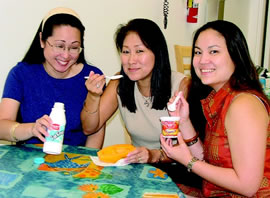Choosing Healthier Snack Foods

|
If your workplace is like mine, there is usually an abundance of community snacks lurking, waiting for hungry people to snatch them up by the handfuls. Often they’re of the yummy, sugar-laden, high fat, and/or salty sort. We all may partake at some time or another at work or home, but if this type of snacking is leading to an expanding waistline, it’s time to check up on our grazing habits.
SNACK ATTACKS
Having the munchies can be normal, depending on what else you eat throughout the day. If you find that you’re hungry between meals or need an energy boost, plan to snack, but do so mindfully. You’re likely to make better choices with planned snacks, either prepared from home or bought ahead of time. People usually run into problems with snacking due to what they snack on and the quantity they eat. Control what you munch on by avoiding game time decisions - when you just grab whatever is around or whatever is convenient, both of which limit your ability to make the best snack choice. Adjust the quantity and base it on the kind of snack it is (healthful = eat a moderate amount, not so healthful = eat very little). Remember, a snack is not a meal - you shouldn’t become full from a snack.
The key to snacking is to consume the amount of calories appropriate for you, spread over the course of the whole day, accounting for the calories that snacks provide. Say, for example, your normal routine is to eat the conventional three meals per day: breakfast, lunch, and dinner. Snacking twice a day, once between breakfast and lunch and again between lunch and dinner is appropriate, as long as you eat less than normal during mealtime. Eating small portions of food, spread throughout the day, can help keep your energy levels up and prevent you from having hunger swings that often result in mealtime gorging, followed by uncomfortable button-popping fullness. Snacking between meals can be helpful in controlling how much food you eat at your next meal as you tend to be less hungry and thus satisfied with less food.
SNACK CHOICES
Snacking can also be healthful if you’re able to use it to fill nutrient gaps in your diet. It’s a great way to get the nutrition you may miss at mealtime - typically fruits, vegetables, and dairy. If you notice that you’re lacking in these or any other food group, make them your snack choices. Whole fruits, cutup vegetables like carrots or celery, low-fat string cheese, yogurt, or a cup of milk can be great snacks. Whole grain breads or crackers, and even nuts make great snacks. The key is to look for snack foods that have protein and complex carbohydrates to satisfy your hunger and provide you long-lasting energy. Minimize the sugary, high-fat snacks that provide little nutrition but lots of calories. When it comes down to it, snacking is what you make of it. Make it a good practice that can support your nutrition and health goals.
Mia Inoshita is a dietitian for Meadow Gold Dairies Hawaii. .(JavaScript must be enabled to view this email address)
E-mail this story | Print this page | Comments (0) | Archive | RSS Comments (0) |
Most Recent Comment(s):





 Del.icio.us
Del.icio.us







